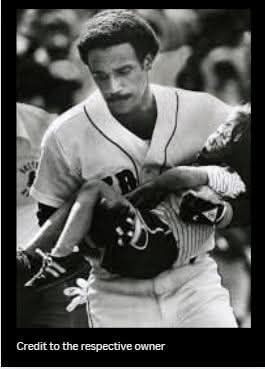Fenway Park, August 7, 1982. The afternoon sun glinted off the green outfield walls. Fans crammed the seats in hopeful anticipation; the crack of bats, the hum of chatter, the smell of peanuts and hot dogs — all the familiar sounds and sensations of America’s pastime. It was just another day at the ballpark, or so everyone thought.
A young family hovered near the front rows, their little boy, only four years old, perched on his father’s lap, eyes wide as he tried to follow the game. Around them, the crowd buzzed, waves of excitement rolling through bleachers and boxes alike. The scent of freshly cut grass mingled with the heat of mid-summer. It was the kind of afternoon you’d remember — only nobody expected it to become seared into memory for all the wrong reasons.
Then came the crack of the bat. A high foul ball sliced sharply off the bat, arcing into the stands. Time slowed. Gasps echoed. The ball flew with dangerous velocity.
In an instant, it struck the child — a glancing blow at first, then more sharply — on the head. The boy went limp. Screams erupted and the crowd froze, paralysed by shock. Some people turned away, others stared in disbelief. Adults leapt up from seats. Parents clutched children closer. A mother screamed for help. And in those heartbeats, the entire stadium’s energy recalibrated from celebration to crisis.
At that moment, one man acted.
Boston Red Sox slugger Jim Rice, stationed near the dugout, recognized the gravity of what had just occurred. Without hesitation, he bolted from his position, crossed the warning track, and surged into the stands. He waded through stunned onlookers, especially in the front rows, and reached the motionless boy. He scooped him up in his arms — unconscious, his body limp and unresponsive.

He carried the small child through the maze of seats, over railings, past stunned spectators, straight to the dugout. Inside, the team’s medical staff was already bracing, but Rice didn’t wait for protocols; every second counted.
Once in the dugout, he laid the boy gently on the floor, exposing the wound, holding him secure. Doctors and trainers swarmed in, checking pulse, airway, pressure, beginning emergency treatment as the crowd looked on in stunned silence. The boy’s parents followed, rushing forward, pleading silently with fate.
In interviews later, medical staff would say that those moments—those precious extra seconds saved by Rice’s swift action—were likely decisive. The injury was serious. The child’s survival hung in the balance. Without immediate care, the outcome could have been worse.
Rice, his uniform stained with blood from either his own hands or contact along the way, remained calm, supportive, vocally coaching the staff, staying present with the family. Some say a life might have been lost had they waited for the usual emergency medical teams or wheels-of-fortune timing.
Against all odds the boy pulled through.
But the story didn’t end that day. In the days that followed, Rice visited him in the hospital. He sat by the child’s bedside, brought flowers, offered reassurance, met with the family, made sure they knew the Red Sox organization and fans were behind them. He made certain that those parents, shaken and frightened, felt less alone.
Back at Fenway, when Rice returned to play in subsequent games, fans looked at him differently. They saw more than a powerful hitter or a feared opponent — they saw courage personified, someone who stepped up not because it was his job, but because it was his humanity.
His bloodstained uniform that day became more than a garment — it became a symbol: of urgency, of caring, of a man who acted without hesitation when others froze. No stat line or home run count could ever capture what he did in those crucial minutes. In a sport known for numbers, records, and legacies, that singular act transcended baseball.
In years to come, people would talk about that game less for the innings or the score, and more for that brief moment when a child’s life was in danger — and a man chose to run toward it, not away.
Fenway Park is still there today: green walls, tight corners, roaring crowds. But stories like this echo through its corridors. They remind us that heroes sometimes live among us, wearing cleats and jerseys — and that in an instant, a moment of bravery can change everything.
The next time you sit at a ballgame, watching fly balls disappear into the stands, remember: sometimes it’s not just about the next inning or the final score. It’s about what you do when something entirely unexpected breaks through the ordinary.